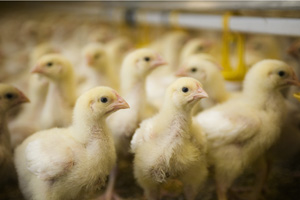Ag co-products in poultry diets reduces emissions

Adding agricultural co-products to poultry diets has the potential to reduce greenhouse gas emissions from poultry production – provided the cost of these co-products remains low and supplies are adequate, a new study suggests.
Scientists from Newcastle and Cranfield Universities carried out a joint study to compare the Global Warming Potential (GWP) of broiler meat and eggs with standard soya-based diets with alternative diets including processed animal protein (PAP) (broilers only) or dried distillers’ grains with solubles (DDGS).
Agricultural co-products, including PAP from the pig industry and DDGS from bioethanol production, are seen as potential alternative feed ingredients in the poultry industry. Using alternative protein sources enables producers to replace the use of soya, the cultivation of which causes high greenhouse gas emissions, related to land use change.
Applying a Life Cycle Assessment (LCA) model of both systems, the researchers made calculations based on typical dietary and production data provided by the broiler and egg industries. In the alternative diets, the soya inclusion was reduced and other ingredients were adjusted to maintain the energy and nutrient levels in the diets, most notably essential amino acids (AA) – although non-essential AAs could increase.
Two inclusion levels of each co-product were applied: ‘Realistic’ and ‘Extreme’, and it was assumed that using the alternative diets would not change animal performance. Economic allocation was used to partition the GWP between co-products (DDGS plus bioethanol, PAP plus tallow plus pig carcass).
“The relative values of these co-products vary depending on supply and demand,” said Dr Leinonen, who led the research.
“Allowing the use of PAP as poultry feed – currently banned – can be expected to increase its price considerably. So, the results were calculated for a range of possible values of the co-products relative to the main product.”
The team found that the GWP of broiler meat could be reduced by up to 11%, with low relative economic values of PAP. DDGS was only beneficial in the layer diets and only when the economic allocation to DDGS was less than 35%.
“The negative effect of DDGS in broilers was partly caused by higher N excretion rates causing higher N2O emissions,” said Dr Leinonen. He added that an assumption was made that the alternative ingredients have no effect on bird performance.
“Quantification of additional environmental criteria is needed to make a holistic judgment on the environmental impacts of these ingredients.”











